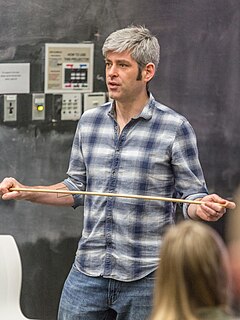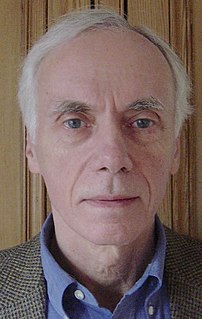Related Research Articles

Jean Hebb Swank is an astrophysicist who is best known for her studies of black holes and neutron stars.

Cornelis A. "Neil" Gehrels was an American astrophysicist specializing in the field of gamma-ray astronomy. He was Chief of the Astroparticle Physics Laboratory at NASA's Goddard Space Flight Center from 1995 until his death, and was best known for his work developing the field from early balloon instruments to today's space observatories such as the NASA Swift mission, for which he was the Principal Investigator. He was leading the WFIRST wide-field infrared telescope forward toward a launch in the mid-2020s. He was a member of the National Academy of Sciences and the American Academy of Arts and Sciences.
Wick C. Haxton is an American theoretical nuclear physicist and astrophysicist.

Alicia Margarita Soderberg is an American astrophysicist who is an assistant professor of Astronomy at Harvard University and a postdoctoral fellow at the Harvard–Smithsonian Center for Astrophysics whose research focuses on supernovae.
Fenton Hill Observatory is an astronomical research facility operated by Los Alamos National Laboratory in the Jemez Mountains of New Mexico, about 35 miles (56 km) west of Los Alamos. The site is home to several astronomical experiments and observatories spanning 30 acres (120,000 m2). It is also known as Technical Area 57 (TA-57) and is located at an elevation of 8,700 feet (2,700 m) in a region shielded from light pollution. Los Alamos National Laboratory has a use agreement with the Forest Service for the 30 acres (120,000 m2), which is located near Fenton Lake State Park.

Gerald Jay (Jerry) Fishman is an American research astrophysicist, specializing in gamma-ray astronomy. His research interests also include space and nuclear instrumentation and radiation in space. A native of St. Louis, Missouri, Fishman obtained a B.S. with Honors degree in Physics from the University of Missouri in 1965, followed by M.S. and Ph.D. degrees in Space Science from Rice University in 1968 and 1970, respectively.
Carl Akerlof is a particle physicist and astrophysicist at the University of Michigan. He initiated and led the Robotic Optical Transient Search Experiment (ROTSE), a ground-breaking effort to find fast astrophysical optical transients, particularly gamma-ray bursts. A fellow of the American Physical Society. he has co-authored over 400 papers with 1500 collaborators, which have been cited over 6000 times.
Ashot Chilingarian is an Armenian physicist known for his contributions to the fields of high-energy astrophysics, space weather, and high-energy atmospheric physics. He is the head of the Cosmic Ray Division (CRD) and the director of the Alikhanyan Physics Institute in Armenia.

The High Altitude Water Cherenkov Experiment or High Altitude Water Cherenkov Observatory is a gamma-ray and cosmic ray observatory located on the flanks of the Sierra Negra volcano in the Mexican state of Puebla at an altitude of 4100 meters, at 18°59′41″N97°18′30.6″W. HAWC is the successor to the Milagro gamma-ray observatory in New Mexico, which was also a gamma-ray observatory based around the principle of detecting gamma-rays indirectly using the water Cherenkov method.

Vassiliki Kalogera is a Greek astrophysicist. She is a professor at Northwestern University and the Director of the Center for Interdisciplinary Exploration and Research in Astrophysics (CIERA). She is a leading member of the LIGO Collaboration that observed gravitational waves in 2015.

Daniel Wayne Hooper is an American cosmologist and particle physicist specializing in the areas of dark matter, cosmic rays, and neutrino astrophysics. He is a Senior Scientist at Fermi National Accelerator Laboratory and an Associate Professor of Astronomy and Astrophysics at the University of Chicago.
Francis Louis Halzen is a Belgian particle physicist. He is the Hilldale and Gregory Breit Distinguished Professor at the University of Wisconsin-Madison and Director of its Institute for Elementary Particle Physics. Halzen is the Principal Investigator of the IceCube Neutrino Observatory at the Amundsen-Scott South Pole Station in Antarctica, the world's largest neutrino detector which has been operational since 2010.
María Magdalena González Sánchez is a Mexican astrophysicist, nuclear physicist, researcher, and professor best known for her contributions in gamma ray research and for being the head of the High Altitude Water Cherenkov Experiment (HAWC). She has published 90 articles about her field of study in indexed journals. In 2015 she received the Sor Juana Inés de la Cruz Recognition from the National Autonomous University of Mexico (UNAM).
Anne L. Kinney is an American space scientist and educator. Kinney is currently the Deputy Center Director at NASA Goddard Space Flight Center. Previously, she held positions as the head of the Directorate for Mathematical and Physical Sciences (MPS) for the National Science Foundation (NSF), the Chief Scientist of the W.M. Keck Observatory, Director of the Solar System Exploration Division at NASA Goddard Space Flight Center, Director of the Origins Program at NASA Jet Propulsion Laboratory, and Director of the Universe Division at NASA Headquarters. She earned a bachelor's degree in astronomy and physics from the University of Wisconsin-Madison and a doctorate in astrophysics from New York University, and has published more than 80 papers on extragalactic astronomy. She was an instrument scientist for the Faint Object Spectrograph that flew on the Hubble Space Telescope.
Eun-Suk Seo is a Korean-American astrophysicist known for her observational research on cosmic rays. She is a professor of physics at the University of Maryland, College Park, where she is also affiliated with the Institute for Physical Science and Technology and heads the Cosmic Ray Physics Group.

Péter István Mészáros is a Hungarian-American theoretical astrophysicist, best known for the Mészáros effect in cosmology and for his work on gamma-ray bursts.
Reshmi Mukherjee is an Indian-American astrophysicist known for her research on gamma-ray astronomy and blazars, involving work based on the Compton Gamma Ray Observatory, VERITAS, Energetic Gamma Ray Experiment Telescope (EGRET), and Cherenkov Telescope Array collaborations. She is Helen Goodhart Altschul Professor of Physics & Astronomy at Barnard College.
Elizabeth Anne Hays is an American astrophysicist at the NASA Goddard Space Flight Center, where she is chief of the Astroparticle Physics Laboratory and the project scientist for the Fermi Gamma-ray Space Telescope. Her research has included gamma-ray astronomy of the Crab Nebula, novae, and gamma-ray bursts.
Lucy Frear Fortson is an American astronomer known for her work on gamma-ray astronomy and Galaxy morphological classification and for her leadership of citizen science projects including the Galaxy Zoo and Zooniverse. She is a professor in the School of Physics and Astronomy at the University of Minnesota.
Dana Dattelbaum is an American physicist and scientist at Los Alamos National Laboratory. She leads NNSA’s Dynamic Materials Properties portfolio at LANL, which provides experimental data, platforms and diagnostics for materials behaviors relevant to nuclear weapons performance, ranging from plutonium to high explosives.
References
- 1 2 3 Curriculum vitae (PDF), Los Alamos National Laboratory, May 2016, retrieved 2020-12-08
- ↑ "Four Corners Section Established by Council", APS News, 6 (6), June 1997
- ↑ "Brenda Dingus", The Presidential Early Career Award for Scientists and Engineers: Recipient Details, National Science Foundation, retrieved 2020-12-08
- ↑ APS Fellows Archive: Fellows nominated in 2006 by the APS Division of Astrophysics, American Physical Society, retrieved 2020-12-08
- ↑ Fellows Biographies: Names and biographies of Laboratory Fellows from 1981 to present, Los Alamos National Laboratory, retrieved 2020-12-08